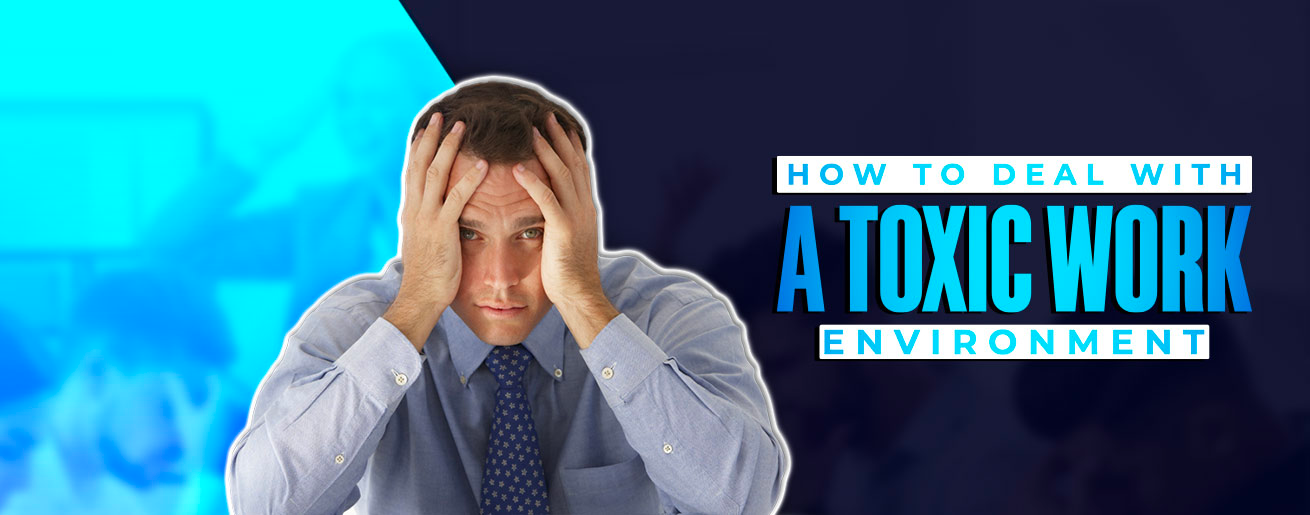How to Deal with a Toxic Work Environment

This guide to how to deal with a toxic work environment shows the warning signs of a toxic workplace. In addition, it provides a few simple rules for reducing the impact of a negative work environment. Ultimately, if nothing changes in a toxic workplace, there are plenty of great careers in Web 3, such as blockchain roles and the metaverse.
If you hate your job, you’ll become part of the job hopping movement, with employees rarely staying longer than one year with a company.
Contents
- The Facts About a Toxic Workplace Environment
- What are the Signs of a Toxic Workplace?
- Six Top Tops: How to Survive a Toxic Workplace
- Conclusion: How to Deal with a Toxic Work Environment
The Facts About a Toxic Workplace Environment
How to deal with a toxic work environment? It’s a subject that became more prevalent in people’s minds as they experienced a shift in their work-life balance after working remotely during the pandemic in 2020. Resignation levels began increasing as workers no longer wanted to figure out how to survive a toxic environment. Instead, they left and found a company that endorsed a positive work environment or allowed them to work from home.
A Statista report states that in 2021, workplace stress caused 33% of short-term absences and 48% of long-term absenteeism because of a negative work environment.

According to a report by Culture Shift, one in seven employees has reported sick because they want to avoid conflict with a colleague. In addition, from the survey of 1,000 employees from a cross-section of industries, 61% took long-term leave after experiencing workplace bullying, sexual misconduct, discrimination, or harassment, and 42% of employees resigned.
Furthermore, 50% of employees said they suffered from emotional distress for up to two years, and 34% said the effects of a toxic workplace lasted over three years. In addition, 71% of employees sought therapy because of the impact on their mental health.
However, things are changing. The 2020 pandemic upturned most companies’ way of working, and employees had to work from home for long periods. Employees experienced relief from the stress of toxic workplace culture and achieved a healthier work-life balance.
As lockdown restrictions eased, those organisations insisting on employees returning to office-based work discovered that they were less tolerant of accepting a negative work environment. Gemma McCall, Culture Trust’s Chief Executive, said, “There are simply just fewer employees that are willing to put up with negative cultures, problematic behaviour and the subsequent impact on their mental health.”
What are the Signs of a Toxic Workplace?
More than 30% of employees felt unheard when they reported workplace issues. For example, Joanne worked for a governmental organisation and, for several years, endured daily bullying from a junior manager. One day, he threatened to push her through an upstairs glass window if she reported his behaviour.
Joanne received no support from management when she escalated her report. Indeed, they dismissed her claim and said she was overreacting. Eventually, after taking several months off from stress, Joanne located to a new department. The bully was never reprimanded and likely continued bullying someone else.
Nobody should have to endure bullying like this at work, but it’s not the only cause of workplace toxicity. Moreover, it’s hard to believe that some organisations aren’t aware of a negative work environment, although it’s easy to spot the 9 signs of a toxic workplace listed below:
#1 High Incidences of Stress-Related Absenteeism
When we are mentally stressed, it can make us physically ill. High cortisol levels create havoc with the immune system. Employees in negative work environments may be in a constant state of the fight or flight response, which is a physiological reaction to perceived danger (supposed to be a short-term response).
Subsequently, if the body produces cortisol over a prolonged period, employees may suffer from depression, anxiety, insomnia, exhaustion, aches and pains, and panic attacks.
#2 High Staff Turnover
Few employees know how to deal with a toxic work environment and, subsequently, decide the only option is to leave the company. Unless the negative work environment is improved, high staff turnover will continue. That gives the company a bad reputation, and it can impact profitability. Employees may join a competitor and disclose valuable information that could drive business away from your organisation. Low employee engagement and retention rates can significantly impact the bottom line .
#3 Poor Workplace Boundaries
It’s a red flag if a company expects employees to prioritise work and sets unrealistic targets. Staff should not be encouraged to stay late, work excessively long hours, or take work home at weekends. Likewise, if an employee leaves, handing their workload over to another employee is unacceptable long-term. In addition, contacting employees at weekends or on holiday leave is also intolerable.
#4 A Blame Culture is the Norm
In this scenario, employees are terrified of making mistakes because they fear public ridicule, reprimand or exposure. After a while, employees hide mistakes and may even make more errors because of the elevated levels of expectation to be perfect 100% of the time. In addition, a blame culture further breaks down the trust between colleagues who may observe mistakes in others and face the dilemma of whether to report the error or not.
#5 A Lack of Trust
Distrust in the workplace becomes pervasive. A lack of trust can manifest in micromanaging employees. Another issue is an overly open office environment where employees cannot escape management’s continuous scrutiny.
When employees have little autonomy for their work, stress can lead to diminished performance.
#6 A Lack of Respect
The foundation of healthy workplace culture is pervading respect between everyone in the company, no matter how lowly their position. People treated respectfully do their best work and are happier to take on more responsibility.
#7 Unhealthy Interpersonal Relationships
Are employees allowed to interact with each other, and is it a relaxed environment? For instance, does the company prohibit employees from talking to each other during work hours? Or is there a drinks station with comfortable seating where employees can occasionally unwind and catch up with co-workers?
A healthy workplace environment is one where employees are allowed to engage with each other. Happy people are more productive, and employee engagement encourages a cohesive workplace where people like and trust each other.
#8 A Lack of Employee Support
A mentor in the workplace helps employees feel supported. They can regularly discuss issues and career opportunities. Furthermore, mentorship is essential for new employees who can quickly become demotivated without support.
#9 Gaslighting
When a new manager took over the sales team, he immediately disliked Peter, a top salesman. Peter was a popular and outspoken team member, which the previous manager had encouraged.
The new manager set impossible sales targets for Peter and criticised him for failing to achieve them, and the goalposts kept moving. In addition, when Peter reported the positives, such as opening new accounts, the manager switched the conversation to negatives. After six months, Peter signed off sick with stress and anxiety and left the company a month later.
Gaslighting employees is demoralising. It often manifests as passive-aggressive behaviour, creating uncertainty and self-doubt, and it’s never acceptable.
Six Top Tops: How to Survive a Toxic Workplace
Few employees love Monday morning, but if you dread going to work because it’s a toxic environment, it’s time to act. If the organisation is not trying to make improvements to the workplace culture, take the following steps whilst you seek another job:
Tip #1: Create a Supportive Network
Seek out like-minded co-workers so that you can support each other. It can often feel like you are unheard in the drama of toxicity, where managers or employees display manipulative or judgemental behaviour. Having someone to talk to about the situation can reduce the decline of your mental health.
If you are genuinely struggling and the stress is beginning to affect your work and home life, seek professional advice from a counsellor or another expert. They can help you to develop better coping mechanisms for managing the daily stress of a negative work environment.

How to handle a toxic work environment
Tip #2: Avoid Workplace Gossip and Drama
Some individuals thrive on gossip and drama, which is not conducive to a healthy work environment. Refuse to engage in gossip because, mostly, it’s likely to be unsubstantiated rumours that can quickly become out of control. People that spread gossip are considered untrustworthy.
Tip #3: Do Not Engage with Negativity
With challenging people, the trick is not to engage with them. If you’re experiencing workplace conflict, reflect upon your reactions to unpleasant communications. Do you react defensively, get angry or tearful? Practice detaching from the situation. It can help if you create a visual image in your head of standing above or outside of the communication. Instead of arguing or defending your position, tell the person you will walk away if they continue to treat you disrespectfully.
Set healthy boundaries with others; although they may not like your rejection, your disengagement will help encourage trust with other employees.
Tip #4: Treat Everyone with Respect
There is no reason to be unkind to others, even though it can be a challenge when people lie and cheat, take credit for your ideas and step over you to gain a promotion. In a negative work environment, stand out as someone people can trust. Become mindful of your triggers and responses and practice deep breathing instead of a knee-jerk reaction.
Be the person that helps everyone else without expectation of reciprocity. In time, your behaviour creates a set of measurable values that will attract others to you. You will sometimes face challenges from bullies and narcissists in the workplace, but stay true to your values, and they gain less (energy) from engaging with you.
Tip #5: Strive for a Healthy Work-Life Balance
When we are stressed, it can consume our lives. We play ongoing scenarios in our heads, stop enjoying relaxation time and, on a Sunday afternoon, start dreading returning to work.
If management or colleagues insist on contacting you over the weekend or during an evening, set a boundary for acceptable expectations. If your manager refuses to accept you have a life outside of work, that person may resist your boundaries. However, the company doesn’t pay you to work 24/7, so stand firm to your terms.
It can be challenging to separate your work from home time if you work remotely. Have a cut-off point in your day for lunch, a few short coffee breaks and close your laptop at the end of the working day. Don’t check work emails or project management channels on your phone.
Tip #6: Look for Another Job
When you have tried everything to improve the workplace culture, and it has failed, it may be time to move to another company. Nobody genuinely knows how to handle a toxic work environment because every situation will be different. Some organisations are enormous and lose employees because nobody has their finger on the pulse of identifying issues in the workplace. Equally, some small companies are just as bad at looking after their employee’s mental health.
Whether you’re working with a toxic boss or battling an overarching culture of toxicity in the workplace, you do not have to put up with it. Many companies in Web3 with a healthy work environment are looking for top talent. To that end, chat with the CB Recruitment team about current vacancies.
Conclusion: How to Deal with a Toxic Work Environment
A 2022 Flexijobs survey of 2,202 employees revealed five core reasons for employees wanting to leave a company:
- Toxic workplace culture 62%
- Low salary 59%
- Poor management 56%
- Unhealthy work-life boundaries 49%
- Not allowing employees to work remotely 43%
It’s not an employee’s job to know how to fix a toxic work environment. It’s something that all organisations should be continually monitoring. Improving the workplace culture can reduce the costs of high staff turnover and increase performance and results.
Moreover, organisations must not ignore bullying, sexual misconduct, discrimination or harassment from management or employees. Subsequently, organisations must learn how to deal with a toxic work environment and take the necessary steps to improve employee working conditions.
About Author

Jan Barley
Jan is a SEO copywriter, brand advisor, content strategist & case study specialist writing for crypto, recruitment, and SaaS companies. Jan lives in the Cotswold's UK with two rescue dogs. Since 2020, Jan has written hundreds of SEO articles for various crypto companies including CB Recruitment & Coin Bureau.
Top Posts

Why Employee Benefits Are Important To Retain Your Workforce
Why are employee benefits important? Since the great resignation of 2021, employees have become sign...

10 Popular Time Management Interview Questions: How to Answer
Why do companies ask candidates time management questions? Effective time management in the workplac...

How to Find the Best Recruitment Consultant (2023)
When looking for a reliable recruitment consultant, you may be concerned about whether they genuinel...


